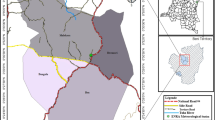Abstract
A statistical scheme based on the Kendall \({\tau}\) statistic, Fisher’s method, the modified Welch t test, and the Gumbel distribution as a special case of the general extreme value distribution was developed to explore the causes of the apparent trends in environmental variables. Daily precipitation data extending as far back as 1898 for gauges in the Nueces, Guadalupe, and San Antonio river basins indicate that the annual maximum daily precipitation depths and the annual 5-day maximum precipitation depth have been generally increasing. The statistical analysis reveals that urbanization, the Pacific Decadal Oscillation, and localized random effects do not contribute to these trends. The results indicate that climate change or other unknown regional phenomena would be the main cause for the increasing trend. The methodology developed can be employed in global change studies to identify the contribution of climate change and other factors, such as societal dynamics, on observed trends in environmental variables.
Similar content being viewed by others
References
Rohde R., Muller R.A., Jacobsen R., Muller E., Perlmutter S., Rosenfeld A., Wurtele J., Groom D., Wickham C.: A new estimate of the average earth surface land temperature spanning 1753 to 2011. Geoinf. Geostat. Overv. 1(1), 1–7 (2013)
Wickham C., Rohde R., Muller R.A., Wurtele J., Curry J., Groom D., Jacobsen R., Perlmutter S., Rosenfeld A., Mosher S.: Influence of urban heating on the global temperature land average using rural sites identified from MODIS classifications. Geoinf. Geostat. Overv. 1(2), 1–6 (2013)
Meehl, G.A.; Tebaldi, C.; Teng, H.; Peterson, T.C.: Current and future U.S. weather extremes and El Nino. Geophys. Res. Lett. 34 (2007). doi:10.1029/2007GL031027
Hulme M., Osborn T.J., Johns T.C.: Precipitation sensitivity to global warming: comparison of observations with HadCM2 simulations. Geophys. Res. Lett. 25, 3379–3382 (1998)
McRoberts D.B., Nielsen-Gammon J.W.: A new homogenized climate division precipitation dataset for analysis of climate variability and climate change. J. Appl. Meteorol. Climatol. 50, 1187–1199 (2011)
Groisman P.Y., Knight R.W., Karl T.R.: Changes in intense precipitation over the central United States. J. Hydrometeorol. 13, 47–66 (2012)
Xu C., Luo Y., Xu Y.: Projected changes of precipitation extremes in river basins over China. Quat. Int. 244, 149–158 (2011). doi:10.1016/j.quaint.2011.01.002
Cheng C.K.M., Chan J.C.L.: Impacts of land use changes and synoptic forcing on the seasonal climate over the Pearl River Delta of China. Atmos. Environ. 60, 25–36 (2012). doi:10.1016/j.atmosenv.2012.06.019
Han J., Baik J., Khain A.P.: A numerical study of urban aerosol impacts on clouds and precipitation. J. Atmos. Sci. 69(2), 504–520 (2012)
Hansen J., Sato M., Ruedy R., Lo K., Lea D.W., Medina-Elizade M.: Global temperature change. Proc. Natl. Acad. Sci. U.S.A. 103(39), 14288–14293 (2006)
Joseph, J.F.; Falcon, H.F.; Sharif, H.O.: Hydrologic trends and correlations in South Texas River Basins: 1950–2009. J. Hydrol. Eng. (2012). doi:10.1061/(ASCE)HE.1943-5584.0000709
Oguntunde P.G., Abiodun B.J., Lischeid G.: Rainfall trends in Nigeria, 1901–2000. J. Hydrol. 411, 207–218 (2011)
McLeod, A.I.: Kendall: Kendall rank correlation and Mann–Kendall trend test. R package version 2.2. http://CRAN.R-project.org/package=Kendall (2011)
R Development Core Team, 2012: R: a language and environment for statistical computing. R Foundation for Statistical Computing, Vienna, Austria. ISBN 3-900051-07-0. http://www.R-project.org/
Hamed K.H.: Trend detection in hydrologic data: the Mann–Kendall trend test under the scaling hypothesis. J. Hydrol. 349, 350–363 (2008)
Carl, P.; Peterson, B.G.: PerformanceAnalytics: Econometric tools for performance and risk analysis. R package version 1.0.3.2. http://CRAN.R-project.org/package=PerformanceAnalytics (2010)
Fisher R.A.: Questions and answers #14. Am. Stat. 2(5), 30 (1948). doi:10.2307/2681650
Shaffer J.P.: Multiple hypothesis testing. Ann. Rev. Psychol. 46, 561–584 (1995)
Jenkinson A.F.: The frequency distribution of the annual maximum (or minimum) values of meteorological elements. Q. J. R. Meteorol. Soc. 81, 158–171 (1955)
Tramblay, Y.; Badi, W.; Driouech, F.; El Adlouni, S.; Neppel, L.; Servat, E.: Climate change impacts on extreme precipitation in Morocco. Glob. Planet. Change 82–83, 104–114 (2012). doi:10.1016/j.gloplacha.2011.12.002
Tryhorn L., DeGaetano A.: A comparison of techniques for downscaling extreme precipitation over the Northeastern United States. Int. J. Climatol. 31, 1975–1989 (2011). doi:10.1002/joc.2208
Wuertz, D.; and many others and see the SOURCE file: fExtremes: Rmetrics—Extreme Financial Market Data. R package version 2160.78. http://CRAN.R-project.org/package=fExtremes (2012)
Arnholt, A.T.: BSDA: Basic Statistics and Data Analysis. R package version 1.01. http://CRAN.R-project.org/package=BSDA (2012)
Author information
Authors and Affiliations
Corresponding author
Rights and permissions
About this article
Cite this article
Joseph, J.F., Sharif, H.O. A Methodology for Assessing Extreme Precipitation Trends Applied to Three South Texas Basins, 1898–2011. Arab J Sci Eng 41, 4945–4951 (2016). https://doi.org/10.1007/s13369-016-2191-6
Received:
Accepted:
Published:
Issue Date:
DOI: https://doi.org/10.1007/s13369-016-2191-6




